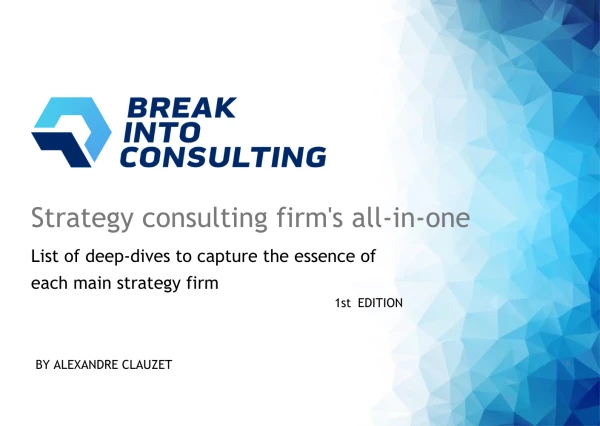I've been trying to build my own issue trees to adjust as much as possible to the particular case, my question is, when NOT following a standard framework, how can I be sure I'm being MECE? Especially when talking about concepts, for instance, "Technology"... or "Legal restrictions"...
How do I know I'm being MECE when creating my own custom issue tree?


Hi,
First of all - not all issue trees can and should be MECE. Very often it's not the case.
Secondly - there is a number of ways how you can approach in a MECE way:
- If your structure works mathematically (e.g. Total time spent on cleaning operation = # of people x Frequency x Hours per cleaning per person)
- If your structure comes from a formula (e.g. output rate = total number of people being served / time to serve one person)
- If you are using the common industry drivers (e.g. revenues = # of customers x av. check) (e.g Passengers on the plane = capacity x Load Factor) or the industry revenue streams (Fuel revenues / non-fuel revenues for the gas station) or the functional drivers (e.g. for the problems in sales : Sales strategy / sales people and allocation / motivation / sales process)
- If your issue tree is a real framework used by the consultants (e.g. the famous Bain Cap framework for PE due dills: Market / Competitors / Company / Feasibility of exit) (e.g. People / Process / Technology) (e.g. The famous McKinsey framework - People don't want to do smth / they can't do smth / smth prevents them from doing that)
- If your structure is a well-known academically MESE framework (e.g. Product / Distribution / Price / Marketing (Also known as 4P))
There is no magic pill how you can learn to build the MESE issue trees. !!!! It comes with a lot of Practice and reflection and building proper industry and functional knowledge. !!!!
Focus on the most common industries in the following priority (sorted by probability of getting a case): 1-retail and CPG; 2-airlines; 3-Telecom; 4-banking; 5-natural resources; 6-tech
There are several sources of information that will help you develop the business sense:
1) Cases - you simply solve 50-70 cases and get a broad knowledge of different industries, common pitfalls and questions. The key here - find good partners who already had case interviews with MBB companies
2) Company reports, equity reports, IB roadshow docs - usually have a good overview of company and industries.
3) HBS cases - quite useful, but not sure if lot's of them available publically. Probably worth buying
4) Industry Books - one good book about airlines with numbers and industry analysis can give you all needed industry knowledge
5) News, Industry blogs
For each industry, you should understand:
- Revenue streams
- Cost structure
- Margins
- Key performance indicators
- Key revenue drivers
- Industry trends
I strongly recommend drawing the typical structures for each industry - profitability, value chain, etc
Then I will switch to getting functional knowledge:
- Marketing (Brand and trade marketing tools, etc)
- Supply chain (Ops metrics like cycle time and throughput time, distribution and delivery specifics, etc)
- Operations (Process optimization basics)
- Finance (Very basic Finance and Valuation)
Good Luck


Dear A,
in general a good structure can be evaluated by a certain depth and breadth. The “depth” should be at least 3-4 levels while the “breadth” should cover the entire solution space. You can cross-check this with the MECE principles (For details see respective article on Preplounge), but the CE (collectively exhaustive) part is basically defining your breadth.
Finally, make sure to check for inter-linkages in your structure and point them out.
Simon













